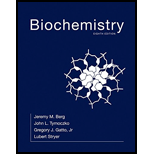
Interpretation:
The reason for the difference in gross value and the net value of ATP formation in glycolysis needs to be explained.
Concept Introduction :
Glycolysis, also termed as the Embden-Meyerhof pathway is an oxidative pathway in which one mole of glucose is converted into two moles of pyruvate. Glycolysis occurs in the cytosol of the cells. It occurs in both aerobic and anaerobic organisms and does not include molecular oxygen.
Explanation of Solution
Glycolysis is divided into two phases, the preparatory phase, and the payoff phase. During the preparatory phase, energy is consumed, but during the payoff phase, energy is produced by the process. The gross energy value is the total amount of energy produced by the glycolysis process. In the payoff phase, four molecules of ATP are produced in the form of energy. The net energy value is the amount of energy actually produced by the glycolysis process. This value takes into account the total energy consumed by the glycolysis process. So, two molecules of ATP are used in the pathway and four ATP molecules are produced, then net ATP production is of two molecules. Due to this, gross and net value for ATP is different in glycolysis.
Want to see more full solutions like this?
Chapter 16 Solutions
Biochemistry
- ATP yield. Each of the following molecules is processed by glycolysis to lactate. How much ATP is generated from each molecule?arrow_forwardBIOCHEMISTRY. Could glycerol be used to regenerate the OAA for maintenance of TCA cycle activity? Yes or No? Explain.arrow_forwardLong explanations are NOT NEEDED. ATP accounting. Consider 1 molecule of the sucrose (monomeric units: glucose and fructose) that will undergo complete oxidation. a. Number of pyruvate molecules after glycolysis.b. Net ATP produced in glycolysis only (via substrate-level phosphorylation).c. Number of NADH produced using the pyruvate dehydrogenase complex reaction.d. Number of NADH and FADH2 produced from Krebs cycle.e. Net ATP produced (complete oxidation via Malate aspartate shuttle).arrow_forward
- Pernicious anemia. Purine biosynthesis is impaired by vitamin B12 B12 deficiency. Why? How might fatty acid and amino acid metabolism also be affected bya vitamin B12B12 deficiency?arrow_forwardLong explanations are NOT NEEDED. Answer only d and e. ATP accounting. Consider 1 molecule of the sucrose (monomeric units: glucose and fructose) that will undergo complete oxidation. -Number of pyruvate molecules after glycolysis is 4.-Net ATP produced in glycolysis only (via substrate-level phosphorylation) is 2.-Number of NADH produced using the pyruvate dehydrogenase complex reaction is 1. Now find:d. Number of NADH and FADH2 produced from Krebs cycle.e. Net ATP produced (complete oxidation via Malate aspartate shuttle).arrow_forwardLess energetic electrons. Why are electrons carried by FADH2FADH2 not as energy rich as those carried by NADH? What is the consequence of this difference?arrow_forward
- Sources of Glucose during Starvation. The typical human adult uses about 160 g of glucose per day, 120 g of which is used by the brain. The available reserve of glucose (~20 g of circulating glucose and ~190 g of glycogen) is adequate for about one day. After the reserve has been depleted during starvation, how would the body obtain more glucose?arrow_forwardLess energetic electrons. Why are electrons carried by FADH 2 not as energy rich as those carried by NADH? What is the consequence of this difference?arrow_forwardBetween two extremes. What is the role of a thioester in the formation of ATP in glycolysis?arrow_forward
- Atp bookkeeping. Explain where the number of 38 and 32 atp per glucose molecules comes fromarrow_forwardDraw Gluconeogenesis. Please make sure to state all the enzymes and co-factors for each step of the pathway.arrow_forward27. Working at cross-purposes . Write a balanced equation showing the effect of simultaneous activation of glycogen phosphorylase and glycogen synthase. Include the reactions catalyzed by phosphoglucomutase and UDP-glucose pyrophosphorylase.arrow_forward
 BiochemistryBiochemistryISBN:9781319114671Author:Lubert Stryer, Jeremy M. Berg, John L. Tymoczko, Gregory J. Gatto Jr.Publisher:W. H. Freeman
BiochemistryBiochemistryISBN:9781319114671Author:Lubert Stryer, Jeremy M. Berg, John L. Tymoczko, Gregory J. Gatto Jr.Publisher:W. H. Freeman Lehninger Principles of BiochemistryBiochemistryISBN:9781464126116Author:David L. Nelson, Michael M. CoxPublisher:W. H. Freeman
Lehninger Principles of BiochemistryBiochemistryISBN:9781464126116Author:David L. Nelson, Michael M. CoxPublisher:W. H. Freeman Fundamentals of Biochemistry: Life at the Molecul...BiochemistryISBN:9781118918401Author:Donald Voet, Judith G. Voet, Charlotte W. PrattPublisher:WILEY
Fundamentals of Biochemistry: Life at the Molecul...BiochemistryISBN:9781118918401Author:Donald Voet, Judith G. Voet, Charlotte W. PrattPublisher:WILEY BiochemistryBiochemistryISBN:9781305961135Author:Mary K. Campbell, Shawn O. Farrell, Owen M. McDougalPublisher:Cengage Learning
BiochemistryBiochemistryISBN:9781305961135Author:Mary K. Campbell, Shawn O. Farrell, Owen M. McDougalPublisher:Cengage Learning BiochemistryBiochemistryISBN:9781305577206Author:Reginald H. Garrett, Charles M. GrishamPublisher:Cengage Learning
BiochemistryBiochemistryISBN:9781305577206Author:Reginald H. Garrett, Charles M. GrishamPublisher:Cengage Learning Fundamentals of General, Organic, and Biological ...BiochemistryISBN:9780134015187Author:John E. McMurry, David S. Ballantine, Carl A. Hoeger, Virginia E. PetersonPublisher:PEARSON
Fundamentals of General, Organic, and Biological ...BiochemistryISBN:9780134015187Author:John E. McMurry, David S. Ballantine, Carl A. Hoeger, Virginia E. PetersonPublisher:PEARSON





